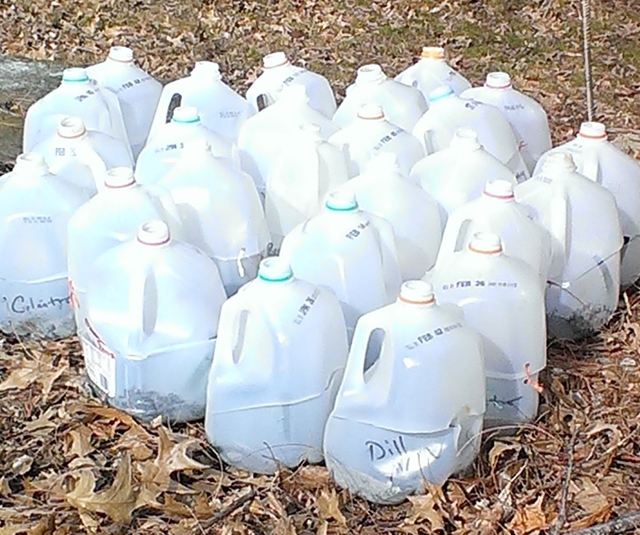What are Sun Tolerant Hostas?
One of the most common questions I hear about hostas is, can hostas handle sun?
First, to dispel a common misconception, there are no sun hostas, no sun-loving hostas, and no sun-proof hostas. There are, however, hostas that tolerate sun much better than their shade-loving cousins. Those are called sun-tolerant hostas.
It's important to remember that sun-tolerant does not mean they are drought-tolerant. Once a hosta's roots are mature, that hosta will be much more drought-tolerant than a younger hosta plant. Hostas need consistent moisture to thrive. Sunlight is rarely an issue, but intense heat and dry conditions are.
When planting hostas in the sun, those hostas will still need protection from the afternoon sun, especially the hotter sun of the dog days of summer. No hosta will survive long if planted in the full, hot sun like a daisy or a sunflower.
An investment in a nice shade cloth will save your hosta from the intense heat. Those Sun Sails functional and pretty.
In Zone 6. Here and north of us, sun-tolerant hostas can generally take four to six hours of direct morning sun but still must be shielded from the afternoon sun.
Hostas that do well in the sun have certain characteristics that allow them to be placed in that category.
Thicker Leaves
Like the leaves of the Hosta Sum and Substance pictured above, hostas for sunny areas generally have thicker leaves that are described as rugose, heavily textured or corrugated. As a bonus, these leaves are usually the most slug resistant ones.
Conversely, hostas with thin leaves will not take as much sun and the leaves can burn when exposed to too much sun Large leaves are able to absorb more water and hold it for its root mass.
Hostas with fragrant flowers, like 'The Shining' pictured above, have a touch of Hosta Plantaginea in their family tree which makes them more sun tolerant.
For these types of hosta to emit the best fragrance, some direct sun is actually necessary.
Leaf Color
Where leaf color is concerned, generally the brighter the leaf color, the more sun the hosta can tolerate.
Yellow
Generally as a rule, hostas with white, yellow or gold tones on the leaves can withstand more sun before the leaves will burn. Their yellow colors will appear brighter when given sun, and without the sun the leaves can quickly fade to green.
Green
Generally the greener the leaf, the less sun is necessary for healthy hosta growth. The green will look even lighter in the sun.
Blue
Where the blue hostas are concerned, in order to keep that gorgeous blue color as long as possible through the season, afternoon shade is mandatory. These blue hostas were bred to be able to take some direct morning sun, but even if the sun-tolerant blue hostas get too much sun, the leaves will turn green or burn. But not to worry, the blue color will return the next year giving you a chance to relocate the hosta until you've hit just the right spot for the color you want.
Variegated Hostas
Variegated sun-tolerant hostas will thrive with some additional sunlight.
Best Care Tips for the Hostas you can grow in Full Sun
Extra water.
At least one inch of water per week during the growing season with a good soaking periodically during the hotter summer months. If you're growing hostas in the hot, southern areas, consider installing a drip irrigation system to keep the hostas well watered.
Soaker hoses are always a good idea.
- Good drainage. Good quality soil with lots of organic matter will hold the moisture well. Avoid clay and compacted soil.
- Mulch. A three-inch layer over the soil will help to conserve moisture and keep the roots cool.
- Throw some shade. Supply some shade sources during the hottest parts of the year. A well-placed trellis, a garden statue or even another larger hosta can provide just the right amount of respite from the sun.
For a full list of sun tolerant hostas click here.
~~~~~~~~~~
Duplicating exact planting conditions for a specific hosta is half-knowledge and half pure luck so experimenting may be necessary.
But since hostas are a very forgiving perennial, they will come back the next season to give you another crack at just the right placement. Once you have it, though, your hostas will give you many years of added beauty to your garden.

Have You Tried Winter Sowing??
If you haven't tried winter sowing, you're in for a treat. This method is especially good for sowing herbs. Winter sowing is basically sowing seeds in the bottom of milk jugs in the winter, setting the milk jugs outside for the winter and leaving them there until the seeds germinate in the Spring.
For our article containing detailed information about Winter Sowing, click here.
To watch our 30 minute video on how to winter sow, click here.
This post may contain Amazon affiliate links, and as an Amazon Associate, I earn from I earn from qualifying purchases without costing you anything extra.
This post may contain Amazon affiliate links, and as an Amazon Associate, I earn from I earn from qualifying purchases without costing you anything extra.




.png)






Thank you so much for lots of great information and pictures.
ReplyDeleteThank for all the information. I have some of the hostas that you listed. It helps me to know where to plant to get the best results. I will be moving some in the fall to better locations.
ReplyDeletePlease email me a list of sun loving hostas and if you have a list of shade loving hostas, I'm a Landscape Designer I design world wide and all of the US and Canada.
ReplyDelete